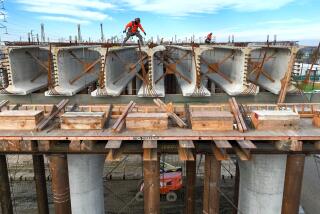Turntable Has Fillmore Rail Fans in a Spin
- Share via
FILLMORE — In many cities, you might be hard pressed to find scores of people anxious to watch a 70-ton piece of brown rusted metal roll into town. But Fillmore isn’t your average community.
On Saturday, more than 100 people flocked to the center of town to watch the delivery of the Santa Clara River Valley Railroad Historical Society’s monstrous rail-car turntable.
“We’ve just been playing up till now,” Dave Wilkinson, owner of the Fillmore & Western Railroad, said as he shaded his eyes to look up at the 88-year-old span of steel. “The real work’s just begun.”
Purchased from the Canadian town of Capreol for $16,000, the turntable is a massive jumble of heavy iron supports held together by thick round rivets. It was, and will be, used to manipulate and link train cars and engines.
Heavy cranes will begin unloading the 96-foot-long bridge-like apparatus as well as giant electric motors and circular track Monday. The society hopes to have it up and running by next fall as the centerpiece of its Railroad Interpretive Center next to City Hall.
The turntable is right at home here, because Fillmore is a railroad town at heart. It grew up with the holler of train whistles and the clanking of box cars. But with the completion of the nation’s web of superhighways in the middle of the century, the nation’s fascination with railroading began to fade, as did the towns that had prospered along the tracks.
Fillmore was no different.
In the early 1900s, the town was a hub of commerce as trains loaded up on the county’s harvest of ripe citrus and vegetables. But by the 1950s, the number of trains pulling into this dusty hamlet began to drop until the railroads pulled up their stakes altogether to move closer to the coast and harbors like the one at Port Hueneme.
“This was a railroad town,” Cecelia Uber of the Fillmore Chamber of Commerce said recently. “That was its heart and soul.”
The community languished with the county’s lowest income rates for several years. But when the 1994 Northridge earthquake leveled parts of the town, city leaders saw a chance to restore its luster.
Now, banking its future on the past, this little town of corner groceries and serene neighborhoods is again feeling the rumble of hundred-ton engines as the community’s interpretive center begins to take shape.
It is hoped that the current train rides through the orchards between Fillmore and Santa Paula, coupled with a museum of massive railroading memorabilia, will coax Southern California residents to the little town for a slice of American history.
“This is going to mean a lot to Fillmore,” society President Paul Haase said of the turntable and interpretive center. “With any luck, it’ll get more people to love trains and get them out here.”
Saturday’s festival-like delivery capped what has been a long and often frustrating project for the society and city.
Members had originally located a turntable in Kansas City, but because it was located in an EPA Super Fund site, the costs and hazards of transporting it were too great for the society and its meager budget.
A year later, they located one for sale in Capreol, in Ontario province. Then, at the last minute, the town decided to keep it, although it later relented.
In August, a handful of society members traveled to Canada to supervise the start of its nearly 3,000-mile transfer to Fillmore.
Along the way it got lost for several days at Chicago’s rail yards. Once found, it proceeded on its journey, but because its enormous size and high center of gravity threatened to throw the train off the tracks at every bend, the journey proceeded at a mule’s pace.
“It wasn’t easy, but it’s here,” said Roy Payton, one of the society members who supervised its international journey. “Now the hard part starts.”
Despite the fact that several companies have agreed to donate their expertise, the city and society will have to spend about $60,000 to reconstruct the turntable. But no one sees that as a problem.
“It’s amazing that we’ve even gotten this far,” said society member Rick Swanson. “This is a pretty ambitious project for a group that’s only been around a few years.”
More to Read
Sign up for The Wild
We’ll help you find the best places to hike, bike and run, as well as the perfect silent spots for meditation and yoga.
You may occasionally receive promotional content from the Los Angeles Times.






